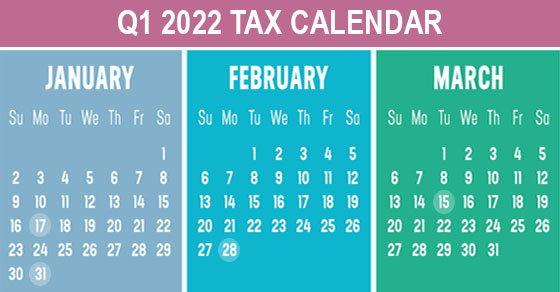During January
All Employers – Give your employees their copies of Form W-2 for 2021 by January 31, 2022. If an employee agreed to receive Form W-2 electronically, post it on a website accessible to the employee and notify the employee of the posting.
January 3, 2022
Employers – Payment of deferred employer share of social security tax from 2020. If the employer deferred paying the employer share of social security tax or the railroad retirement tax equivalent in 2020, pay 50% of the deferred amount of the employer share of social security tax by January 3, 2022. The remaining 50% of the deferred amount of the employer share of social security tax is due by January 3, 2023. Any payments or deposits made before January 3, 2022, are first applied against the payment due by January 3, 2022, and then applied against the payment due on January 3, 2023.
Employers – Payment of deferred employee share of social security tax from 2020. If the employer deferred withholding and payment of the employee share of social security tax or the railroad retirement tax equivalent on certain employee wages and compensation between September 1, 2020, and December 31, 2020, it should have withheld and paid those taxes ratably from wages paid to the employee between January 1, 2021, and December 31, 2021. The employer is liable to pay the deferred taxes to the IRS and must do so before January 3, 2022.
January 10, 2022
Employees – who work for tips. If you received $20 or more in tips during December 2021, report them to your employer. You can use Form 4070.
January 18, 2022
Individuals – Make a payment of your estimated tax for 2021 if you did not pay your income tax for the year through withholding (or did not pay in enough tax that way). Use Form 1040-ES. This is the final installment date for 2021 estimated tax. However, you do not have to make this payment if you file your 2021 return (Form 1040 or Form 1040-SR) and pay any tax due by January 31, 2022.
Employers – Social Security, Medicare, and withheld income tax. If the monthly deposit rule applies, deposit the tax for payments in December 2021.
Employers – Nonpayroll Withholding. If the monthly deposit rule applies, deposit the tax for payments in December 2021.
Farmers and Fishermen – Pay your estimated tax for 2021 using Form 1040-ES. You have until April 18 (April 19 if you live in Maine or Massachusetts) to file your 2021 income tax return (Form 1040 or Form 1040-SR). If you do not pay your estimated tax by January 18, you must file your 2021 return and pay any tax due by March 1, 2022, to avoid an estimated tax penalty.
January 31, 2022
Individuals who must make estimated tax payments. If you did not pay your last installment of estimated tax by January 18, you may choose (but are not required) to file your income tax return (Form 1040 or Form 1040-SR) for 2021 by January 31. Filing your return and paying any tax due by January 31, 2022, prevents any penalty for late payment of the last installment. If you cannot file and pay your tax by January 31, file and pay your tax by April 18 (April 19 if you live in Maine or Massachusetts).
Employers – Give your employees their copies of Form W-2 for 2021. If an employee agreed to receive Form W-2 electronically, have it posted on a website and notify the employee of the posting. File Form W-3, Transmittal of Wage and Tax Statements, along with Copy A of all the Forms W-2 you issued for 2021.
Businesses – Give annual information statements to recipients of certain payments made during 2021. You can use the appropriate version of Form 1099 or other information return. Form 1099 can be issued electronically with the consent of the recipient.
Payers of nonemployee compensation – File Form 1099-NEC for nonemployee compensation paid in 2021.
Payers of Gambling Winnings – If you either paid reportable gambling winnings or withheld income tax from gambling winnings, give the winners their copies of Form W-2G.
Employers – Nonpayroll taxes. File Form 945 to report income tax withheld for 2021 on all nonpay-roll items, including backup withholding and withholding on pensions, annuities, IRAs, gambling winnings, and payments of Indian gaming profits to tribal members. Deposit or pay any undeposited tax under the accuracy of deposit rules. If your tax liability is less than $2,500, you can pay it in full with a timely filed return. If you deposited the tax for the year timely, properly, and in full, you have until February 10 to file the return.
Employers – Social Security, Medicare, and withheld income tax. File Form 941 for the fourth quarter of 2021. Deposit or pay any undepos-ited tax under the accuracy of deposit rules. If your tax liability is less than $2,500, you can pay it in full with a timely filed return. If you deposited the tax for the quarter timely, prop-erly, and in full, you have until February 10 to file the return.
Employers – Federal unemployment tax. File Form 940 for 2021. If your undeposited tax is $500 or less, you can either pay it with your return or deposit it. If it is more than $500, you must deposit it. However, if you deposited the tax for the year timely, properly, and in full, you have until February 10 to file the return.
Certain Small Employers – File Form 944 to report Social Security and Medicare taxes and withheld income tax for 2021. Deposit or pay any undeposited tax under the accuracy of deposit rules. If your tax liability is $2,500 or more for 2021 but less than $2,500 for the fourth quarter, deposit any undeposited tax or pay it in full with a timely filed return. If you deposited the tax for the year timely, prop-erly, and in full, you have until February 10 to file the return.
Farm Employers – File Form 943 to report Social Security and Medicare taxes and withheld income tax for 2021. Deposit or pay any undeposited tax under the accuracy of deposit rules. If your tax liability is less than $2,500, you can pay it in full with a timely filed return. If you deposited the tax for the year timely, properly, and in full, you have until February 10 to file the return.














